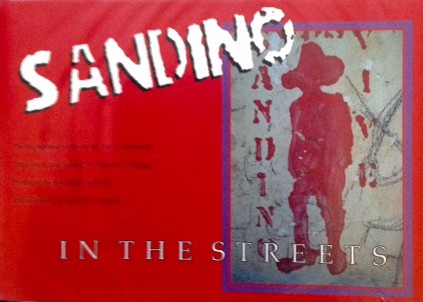Inspiring Older Readers
 posted on 19 Jan 2018
posted on 19 Jan 2018
Sandino In The Streets by Joel E. Sheesley
Back in the highly politicised atmosphere of the early 1980s a badge I picked up on one of the innumerable marches I went on expressed its support for the for the Sandanista movement in Nicaragua. On that badge was the image of a man in a broad-brimmed hat staring defiantly out at us all. So what was it all about?
After 40 years of dictatorship by the right wing general known as Samoza, the revolutionary Sandanista National Liberation Front (FSLN) had, in 1979, finally ousted the hated general. But their governance of the country proved to be as rocky and difficult as their road to power had been and that was largely because of the covert efforts of the USA who funded a counter-revolutionary movement known as The Contras. Despite almost continuous civil war the revolutionary government did fantastic things in health care and education and survived until 1990 when they were voted out of power. The party remains one of Nicaragua’s leading parties but now adopts a more liberal, social democratic stance.
Back in the 1980s the FSLN, like the regime in Cuba, seemed to offer a genuine alternative to the growing neo-liberalism that was sweeping the Western world and so it was natural to be curious about the origins of the name ‘Sandinista’. The answer to that question seemed to simply enhance the romance of the revolution: Augusto Sandino was the revolutionary leader of rebellion against the US military occupation of 1927-1933 and a national hero who was effectively executed in 1934 by Samoza’s forces before the dictator seized power. This had transformed him from freedom fighter to mythical patriot and in Nicaragua his name came to stand for liberation and sovereignty.
And like other great revolutionary icons, Sandino had a fantastic trademark image – wide-brimmed hat and high-laced boots (the man on my badge) – that made his picture endlessly reproducible. In fact the image itself came to stand for the values of progressive, left of centre rebellion and progress and its use marked the active presence of individuals or groups who were not prepared to let his legacy die. During the years of the FSLN government, Sandino’s distinctive stencilled silhouette popped up everywhere – across Nicaragua and out in the wider world where the fate of the revolution was being avidly followed.
What Sheesley’s book does is to bring together photographs of the graffiti showing the Sandino image – making bold and sometimes even abstract statements on walls, doors and pavements. The pictures are supplemented with entries taken from Sandino’s diaries, journals and letters and there are other official documents relating to Nicaraguan history and social movements.
I love the sheer frisson of ‘people power’ that’s inherent in these images – defiant symbols of a commitment to ideas that were exciting, revolutionary and patriotic. Like Che’s legendary image of the revolutionary in a beret, Sandino’s silhouette promises hope and a refusal to be cowed by oppressive authoritarian dictatorships.
Brave and bold stuff and I love it.
The book isn’t easy to find but you can pick up copies on the second hand book websites and it won’t break the bank.
Terry Potter
January 2018